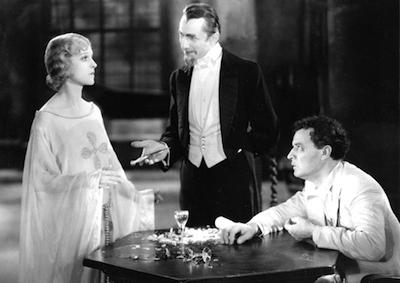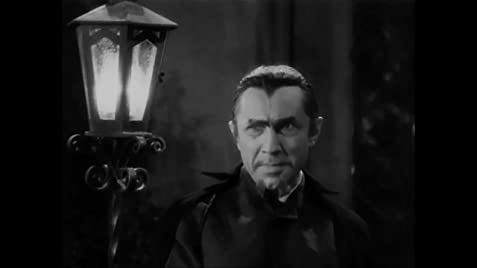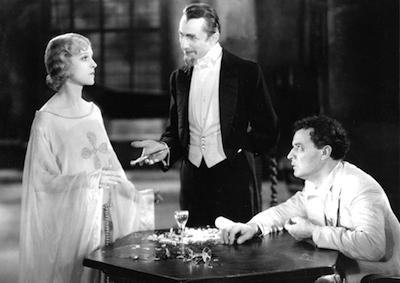
- Details:
- Directed by Victor Halperin
- Produced by Edward Halperin
- Written by Garnett Weston (story and dialogue)
- Starring Bela Lugosi, Mage Bellamy, Joseph Cawthorn, John Harron, and Robert W. Frazer
- Released July 28, 1932
- Length 1 hour 10 minutes
Break down:
The film follows Madeleine short and her fiancé Neil Parker as the couple travels to Haiti to be married. They are invited to the home of a wealthy plantation owner, Charles Beaumont. On the way to Beaumont’s castle, the couple passes a mysterious man with ghostly eyes. He approaches the couch and stares at them as he takes Madeleine’s scarf. When the couple makes it to the castle, it is revealed to the viewer that Charles Beaumont is, in fact, in love with Madeleine himself and will stop at nothing to have her.
Charles goes to the mysterious man whose name is Murder Legendre and makes a deal with him to turn Madeleine into the living dead to keep her for himself. Charles gives Madeleine a potion, and shortly after her marriage to Neil Parker, the brew begins to take effect, and Madeleine dies and is buried. Later that night, Charles and the witch doctor Murder go into Madeleine’s tomb and bring her back to life as a zombie. When Neil finds the tomb empty later, he goes to a local preacher to ask for help. The preacher lets Neil know that Murder has turned many of his enemies into zombies. Together, Neil and the preacher leave to head to the castle where Murder lives. By this time, Charles regrets his actions in turning Madeleine into a zombie and when he asks Murder to turn her back, Murder instead slowly turns Charles into a zombie. The effects are prolonged, and Murder seems to take great pleasure in watching the process as he states that Charles is the first person to know what is happening to him. When Neil and the preacher get to the castle, Murder tries to get Madeleine to kill Neil. The preacher grabs her hand as she attempts to stab Neil, and she drops the knife and turns to walk away. Murder seems to no longer have control of her. She walks outside and attempts to jump off the cliff but right before she does so, Neil grabs her and pulls her back. While Murder tries to get his zombie followers to kill the trespassers, Charles, in a last-ditch effort to save his humanity, pushes Murder over the cliff to his death.
White Zombie is often looked at as a cornerstone in a horror film. What the film Dracula did for the vampire genre, White Zombie did for zombie films. Not the flesh-eating, mindless animals that zombies are portrayed as now, but instead, in this film, the zombies are emotionless, brainless slaves who are forced to carry out their master’s desires.
In 1931 the films Dracula and Frankenstein were released to the masses to great success. When the film industry realized that the horror genre was here to stay, big studios and independent filmmakers began to produce their favorite horror stories and plays as motion pictures and some entirely new horror concepts. One of these such films was the 1932’s film White Zombie.
The idea of a slave type of zombie was first introduced in Haitian folklore. The lore spoke of human bodies being reanimated using voodoo or witchcraft, most commonly for slave labor—however, the idea of the dead being raised dates back to ancient Mesopotamia.

In the Descent of Ishtar, it is written:
“If you do not open the gate for me to come in,
I shall smash the door and shatter the bolt,
I shall smash the doorpost and overturn the doors,
I shall raise up the dead, and they shall eat the living:
And the dead shall outnumber the living!”
This seems to be the earliest writings of the dead walking amongst the living and the foundation for the flesh-eating zombies pop culture knows today. But in Victor Halperin’s film, White Zombie, the horror is more of what the living man can do, not the reanimated.
The legendary Bela Lugosi brings the witch doctor Murder Legendre to life on screen, so to speak. His eerie, soul penetrating eyes make every scene he is in dark and uninviting. By the time this film came out, Lugosi was already a horror start after playing Dracula a year earlier. It is said that although playing Murder Legendre was one of Lugosi’s favorite roles, he always regretted agreeing to play the role for such a low fee. Although the total amount that he was paid has never been proved, it is said that he was paid a flat sum of $800 for the role, while others state the amount was closer to 5k. It is more than likely that Lugosi was paid a small sum since the entire film budget was only $50k and shot in just 11 days. In fact, to keep the budget low on the film, set designer Ralph Berger used already made rented sets from some previous films, including Dracula and The Hunchback of Notre Dame.
Upon its release, it was met with mostly poor criticism. Aside from Lugosi, the cast was primarily washed-up silent film stars, and the press took notice. One reviewer from the New York World-Telegram stated, “The plot is really ridiculous, but not so startling so as the acting.” The New York Evening Post wrote, “The story tries to out-Frankenstein Frankenstein, and so earnest is it in its attempt to be thrilling that it overreaches its mark all along the line and resolves into an unintentional and often hilarious comedy.” However, the time has proven otherwise, as White Zombie has become a cult classic, even inspiring Rob Zombies stage name and first band, White Zombie.
A fantastic look into the birth of horror films as we know them today, White Zombie is a must-see film for any fan of the genre. The use of constant music throughout the film, where others would let the silence stretch out, speaks volumes to the director’s vision and the composers. Although the movie was inspired by the book The Magic Island by William Seabrook, Garnett Weston’s screenplay is a unique story that is entertaining to watch all these years later.
Watch “White Zombie” on TheLastPicture.Show
Written exclusively for TheLastPicture.Show by Jacob Ruble
Disclosure: The links on this page are “Affiliate Links” and while these are shown at no costs to our viewers, they generate commissions for our website(s)


